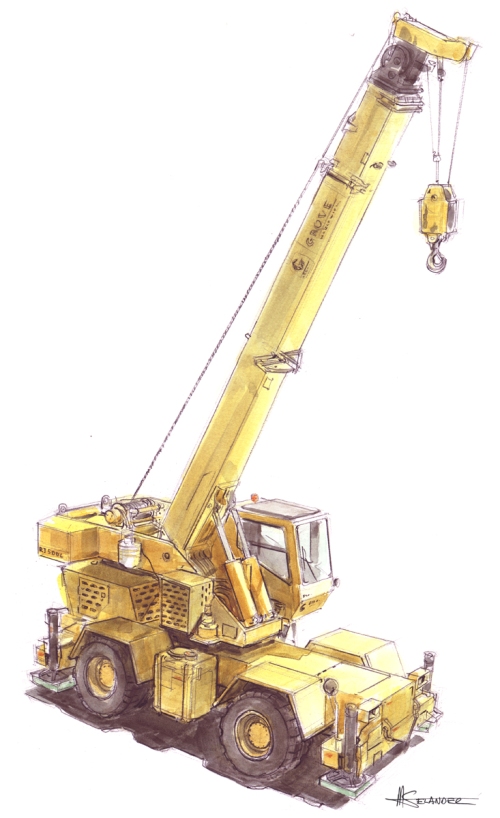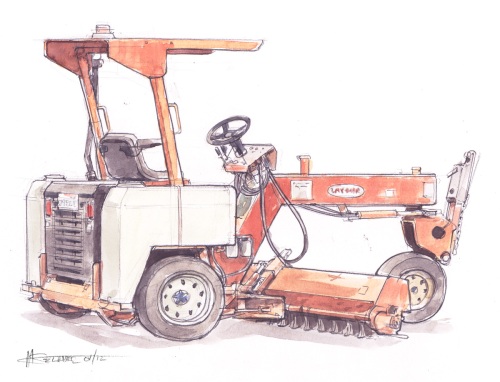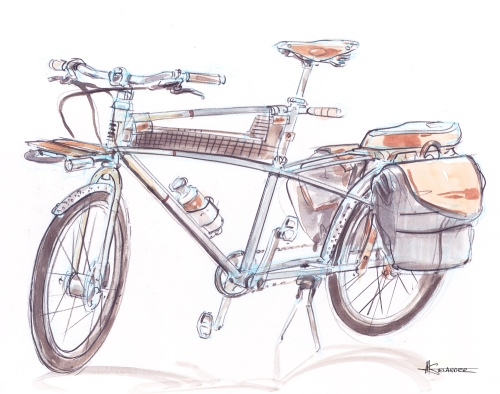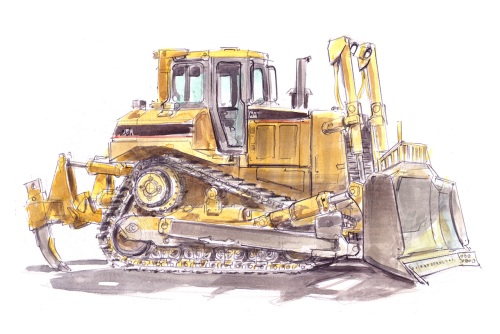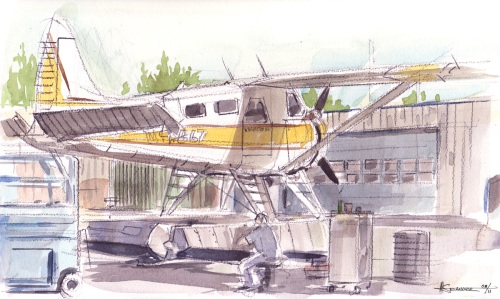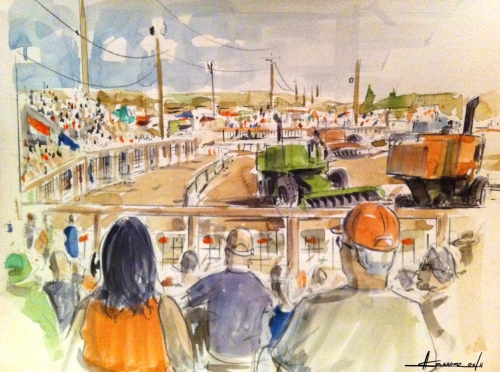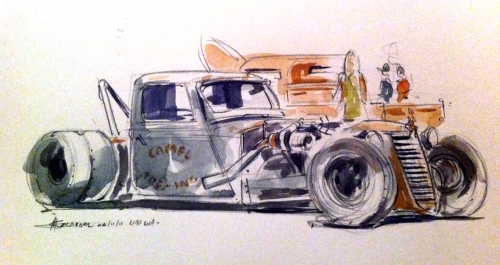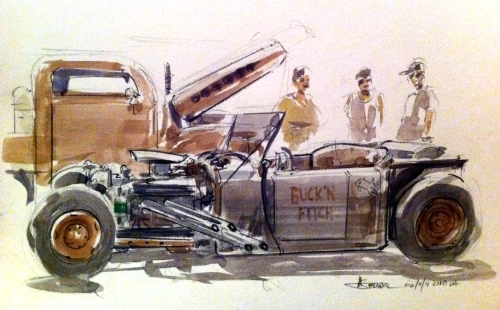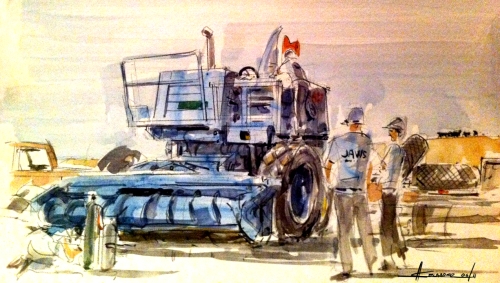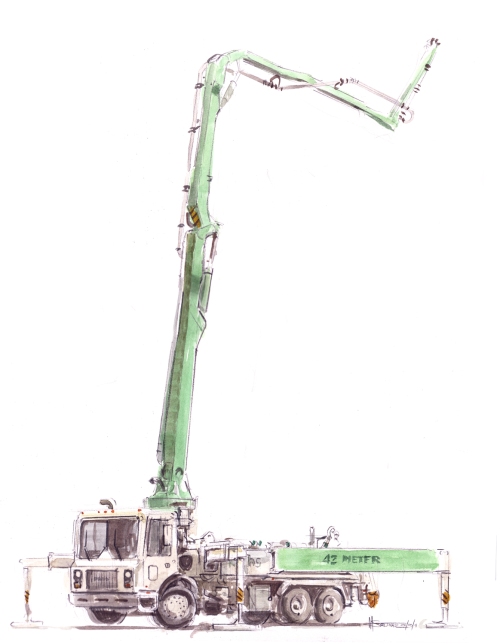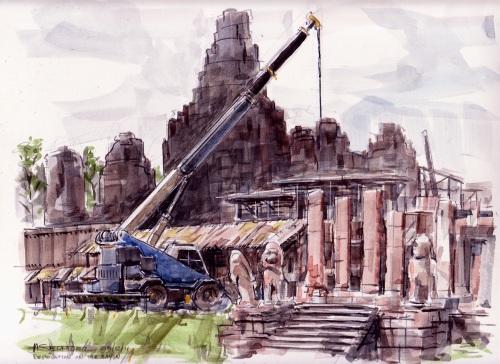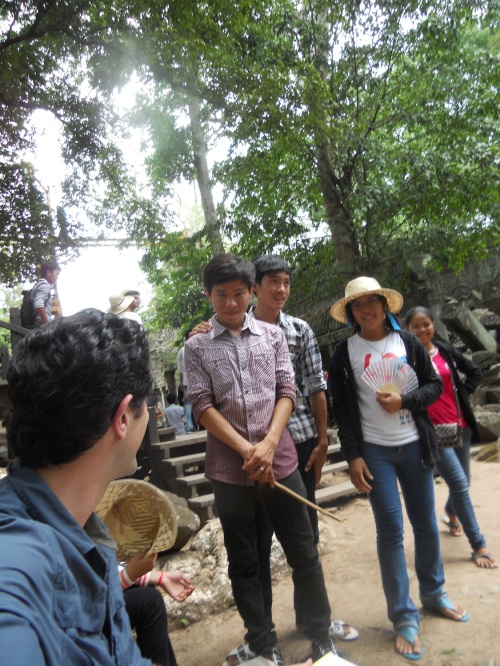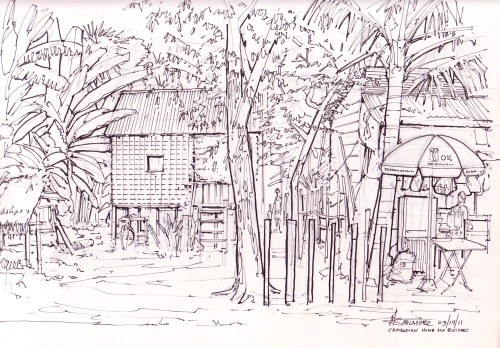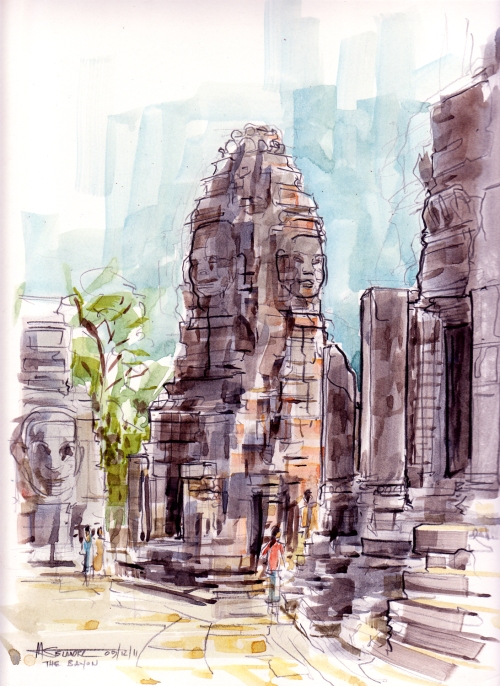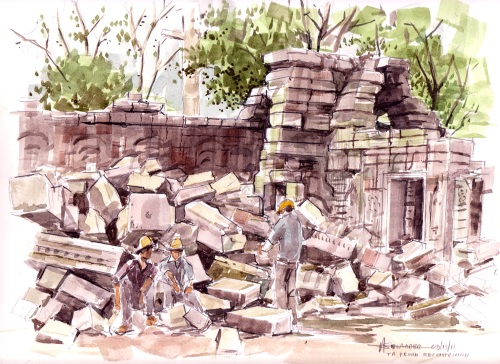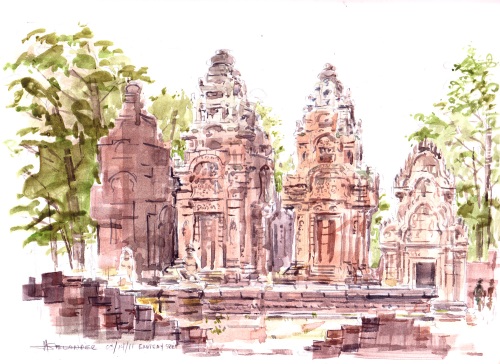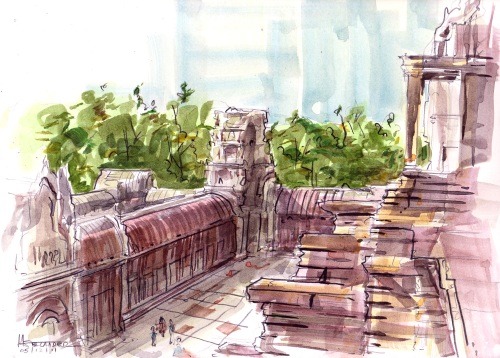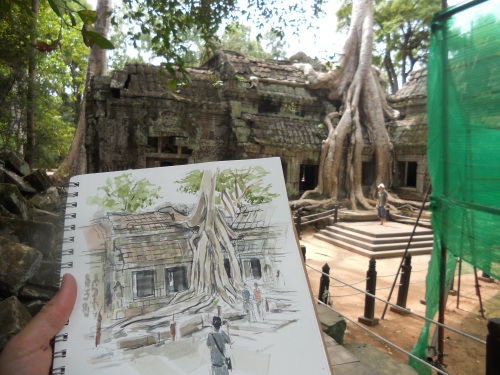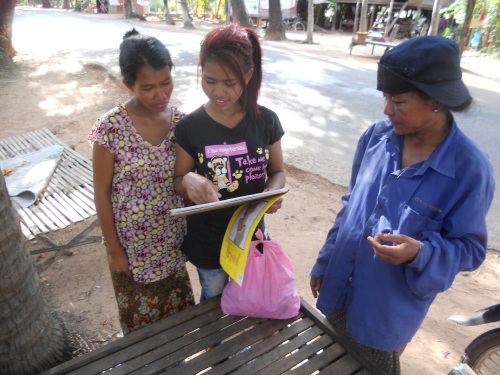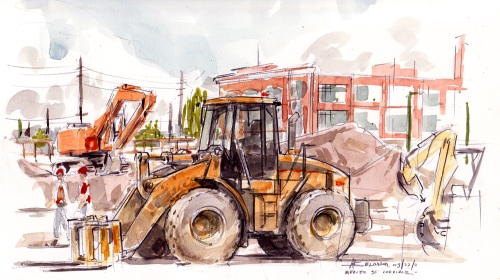 There are two things I want to say about this painting, no..three things. The first is that this isn’t the first time I’ve tried painting this scene. I drive by this site constantly and the scale of the project and the revisions to traffic and occasional long wait times to get onto the freeway can’t be ignored. Normally I might find myself getting impatient, but since I get a view of this site with it’s armada of construction equipment I always look forward to it (this is the second thing I wanted to say). Back in April when I last had been here, I recall it was a very nice and sunny day. I decided to actually stop into the site during lunch hours when it appeared to be less busy than usual. A few workers and machines were moving around, but it was fairly tame. I asked one of the workers if it would be alright if I stopped there for an hour. He was ok with it, so I parked my Honda Element on some gravel and did my best to make sure my car wouldn’t be in the way of any movement. I started to draw and everything was going fine, my drawing was coming together and I was about ready to put down some paint. At this point some of the construction work started to increase, there were dump trucks moving around and a few of the loaders were shuttling back and forth. I’m always sort of hyper aware of my presence in a place and the last thing I ever want to be is “in the way”, especially if people are working. I felt like it was time for me to move my car, even though I hadn’t finished the painting. I put the key in the ignition, turned it, and….nothing, just a gasping cough of my engine as it attempted to turn over. A sick feeling came over me. I moved my hand towards the headlight switch and realized it was in the “On” position. Again I tried the ignition, “No no no no!, Not now, PLEASE turn over!” I begged my car as the construction traffic began to increase. This went on for about a minute, and then as anybody who has ever killed their battery can tell you, I realized I had to get outside help. Let me put this in a little more context. I have the greatest respect for people that do physical labor for a living. In truth I look up to them. For work I draw, and I use a computer, and sometimes I talk. This can be very draining, challenging, difficult, and of course rewarding. It’s work and a working day is a working day, but sometimes, I question this. Lifting heavy objects, working out in the sun, (or rain), toiling, this is work. I’ve always viewed it as somehow purely valid as labor and demanding of respect. So here I am in my Honda Element stuck in the middle of a major construction site with a dead battery, a pile of paint brushes, and a drawing of a Bulldozer in my lap as worker dudes are driving massive machines around me lifting loads of gravel from pile to pile.
There are two things I want to say about this painting, no..three things. The first is that this isn’t the first time I’ve tried painting this scene. I drive by this site constantly and the scale of the project and the revisions to traffic and occasional long wait times to get onto the freeway can’t be ignored. Normally I might find myself getting impatient, but since I get a view of this site with it’s armada of construction equipment I always look forward to it (this is the second thing I wanted to say). Back in April when I last had been here, I recall it was a very nice and sunny day. I decided to actually stop into the site during lunch hours when it appeared to be less busy than usual. A few workers and machines were moving around, but it was fairly tame. I asked one of the workers if it would be alright if I stopped there for an hour. He was ok with it, so I parked my Honda Element on some gravel and did my best to make sure my car wouldn’t be in the way of any movement. I started to draw and everything was going fine, my drawing was coming together and I was about ready to put down some paint. At this point some of the construction work started to increase, there were dump trucks moving around and a few of the loaders were shuttling back and forth. I’m always sort of hyper aware of my presence in a place and the last thing I ever want to be is “in the way”, especially if people are working. I felt like it was time for me to move my car, even though I hadn’t finished the painting. I put the key in the ignition, turned it, and….nothing, just a gasping cough of my engine as it attempted to turn over. A sick feeling came over me. I moved my hand towards the headlight switch and realized it was in the “On” position. Again I tried the ignition, “No no no no!, Not now, PLEASE turn over!” I begged my car as the construction traffic began to increase. This went on for about a minute, and then as anybody who has ever killed their battery can tell you, I realized I had to get outside help. Let me put this in a little more context. I have the greatest respect for people that do physical labor for a living. In truth I look up to them. For work I draw, and I use a computer, and sometimes I talk. This can be very draining, challenging, difficult, and of course rewarding. It’s work and a working day is a working day, but sometimes, I question this. Lifting heavy objects, working out in the sun, (or rain), toiling, this is work. I’ve always viewed it as somehow purely valid as labor and demanding of respect. So here I am in my Honda Element stuck in the middle of a major construction site with a dead battery, a pile of paint brushes, and a drawing of a Bulldozer in my lap as worker dudes are driving massive machines around me lifting loads of gravel from pile to pile.
My options
1.) Call AAA and ask for assistance. Could be an hour at least.
2.) Flag down a worker on the site, “Hey uh..sorry to bother you man, but uh…does that bulldozer by any chance have any jumper cables?”
3.) Call my friend Alex who works down the street.
I call Alex. He’s as reliable as they come, and of course he has cables in his car. In 5 minutes he’s there…driving a Honda Element. So even as I cringe at the embarrassment of killing my battery – while painting – in a Honda Element – on a site where the vehicle of choice is a muddy white Ford F-150 or a dirt embedded yellow 25 Ton Caterpillar D7, he drives up into the lot with his “Galapagos Green Metallic” Honda Element, and faces my “Eternal Blue Pearl” Honda Element. We go through the magical ritual of automotive resuscitation, the engine breathes again, and after talking for a few minutes in our “Rigs” he heads back to his office and I decide half heartedly to finish my painting. It was one of those things where I had lost energy and just wanted to get out of there. It’s certainly not worth showing here, but I knew I had to go back to the same spot.
So here’s the third thing I wanted to say. On Sunday, I finally made it out to a Seattle Urban Sketching Sketchcrawl. The group meets once a month, and this month everyone got together at Vivace across from REI. After pre-sketching niceties, everyone disperses to go draw for 2 hours and then makes plans to meet back up and share the work. I had no doubt what I would draw. I beelined (sort of) to the construction site on Mercer, but this time just had my backpack, and a folding stool. On a Sunday morning the site was active, so again I asked permission and was given the go ahead to draw. I spent about an hour and a half there and probably talked to 5 guys from the site that came up to see what I was doing. Everyone was supremely cool and friendly, even as I was again painting while they were in the middle of pouring cement and shoveling gravel. I got the lowdown on the project (much needed road widening and traffic revision from Dexter up to the freeway on ramp, and construction along 9th as it flows into Mercer). I sincerely hope this does help solve part of the traffic congestion in the area.
Now with all this said, I will continue to draw and paint construction machines, continue to meet-up with the fine folks I met at the Sketchcrawl, and no doubt continue to drive my blue Honda Element into and around industrial sites, and since this wasn’t the first time I’ve killed my battery in an inopportune location (yah), it will probably happen again. Maybe I should go draw some tow trucks.

